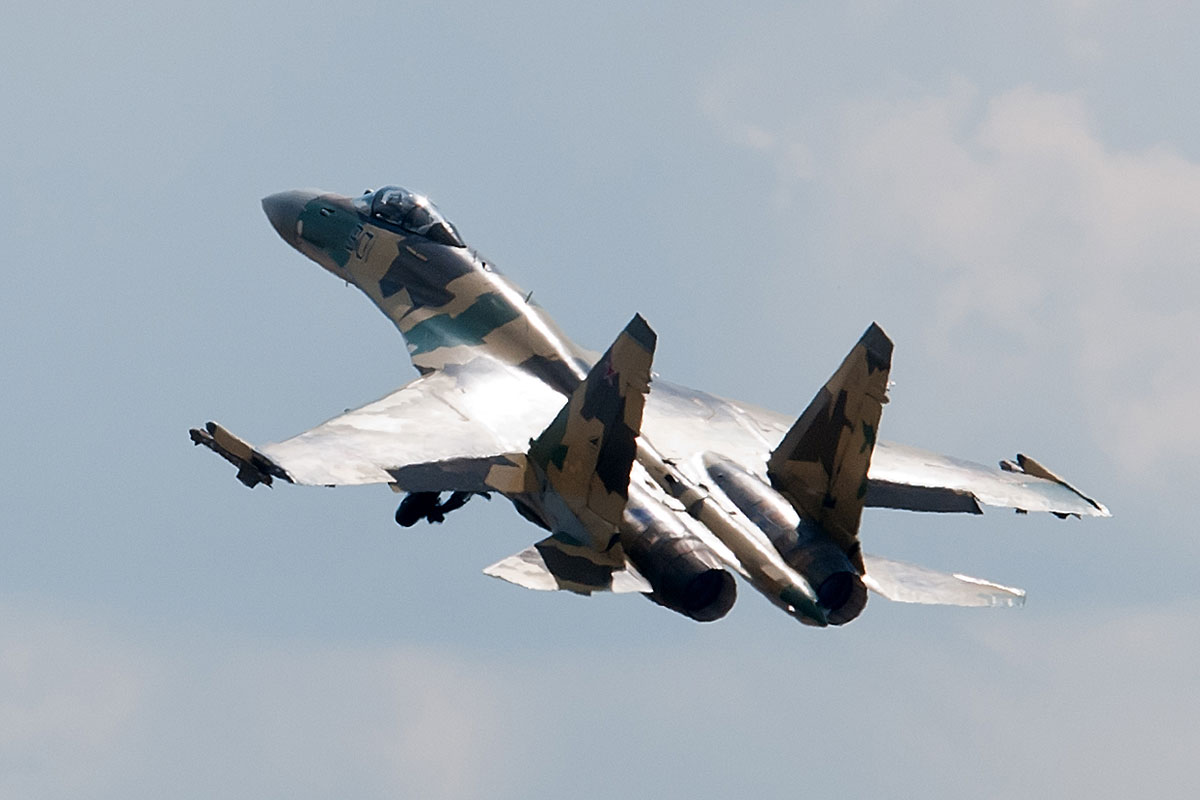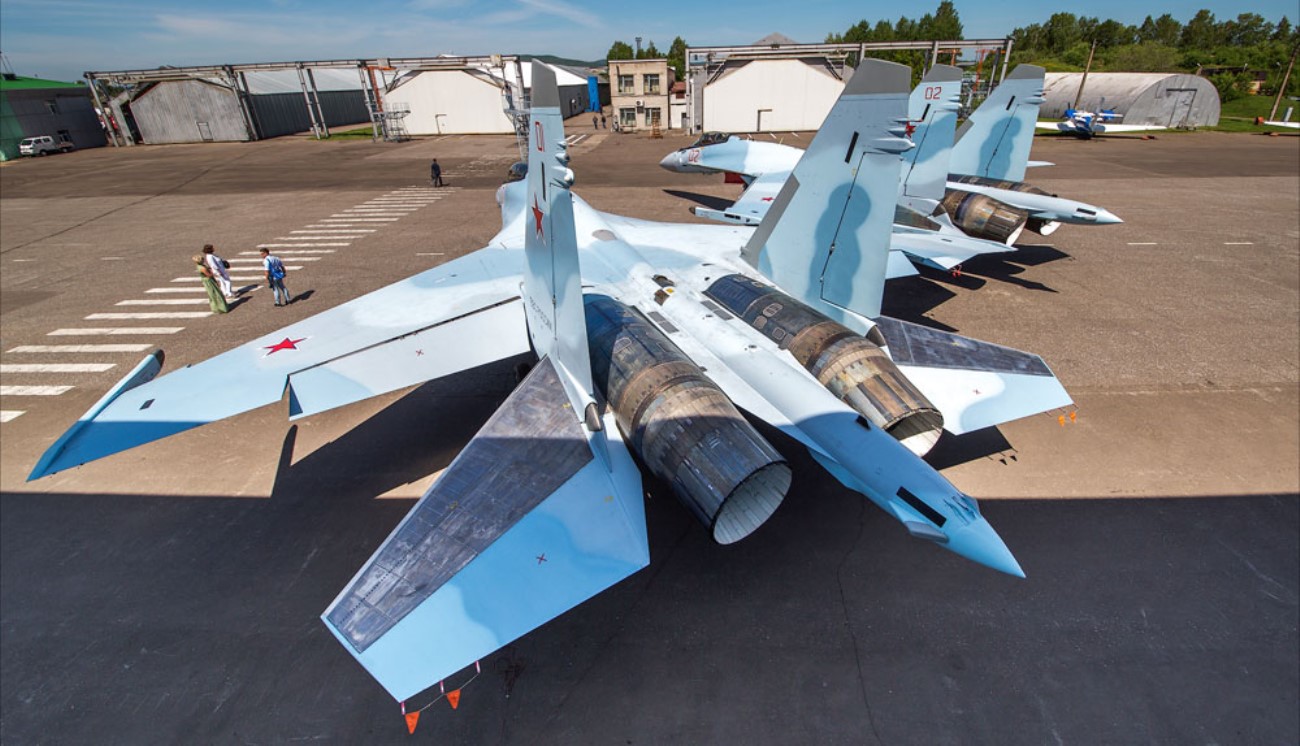Su-35 Fighter Jets - Here's what to remember: the threat of the Su-35 is not only in what the plane can do in the air, but also in what the plane can do in the air. This is because the Russian Air Force is not the only operator of these advanced aircraft and what this means for the regional balance of power.
Throughout the latter part of the Cold War, American fighter jets generally seemed to have the upper hand against anything the Soviets had to offer. This also applies to the Su-27, which was introduced in 1988. In the past two decades, the jet has never outperformed the American F-15. But the newest derivative of the Su-27 poses a real threat in the skies.
Su-35 Fighter Jets

The Sukhoi Su-35S is actually a second upgraded version of the Su-27M; it's a single-seat, twin-engine, super-maneuverable aircraft. This version of the 35S has a thrust vectoring engine instead of the canard of the Su-27. Designated the "Flanker-E" by NATO, this "4++ generation" fighter has proven to be a formidable opponent to current US aircraft, including the F-15 Eagle, F-18 and even the F-35. Lightning II.
Pla Signs Preliminary Deal For 24 Russian Su 35 Jet Fighters
The Su-35's armament includes a GSh-30-1 30mm autocannon with 150 rounds, along with a payload of 17,630 kilograms in twelve external points. It can carry a variety of air-to-air, air-to-surface, anti-radiation and anti-ship missiles, as well as various TV bombs, lasers and guided satellites. By comparison, the US-built F-22 has only four hardpoints on the wing and three in the internal weapons bay.
Twin Saturn AL-41F1S turbofans provide the Su-35 with maneuverability that can easily match or exceed the evasion techniques of nearly any fourth-generation fighter in existence. With a maximum speed of 1,550 mph and a ceiling of 59,050 feet, it is a well-armed and fast aircraft.
However, defense analysts suggest that the Su-35 in its current modified configuration is truly a stopgap measure, at least until the Russian military ramps up production of its fifth-generation stealth multirole fighter, the Sukhoi Su-57. .
The threat of the Su-35 is not only in what the aircraft can do in the air, but also in. This is because the Russian Air Force is not the only operator of these advanced aircraft and what this means for the regional balance of power. In fact, the fighter was originally designed for export, but the Russian Air Force became the launch customer in 2009.
Russia's Su 35 Fighter Jets Sent To Syria [infographic]
The People's Liberation Army Air Force of China (PLAAF) and the Indonesian Air Force have ordered - with the former receiving an initial delivery of four aircraft in 2016, followed by a further ten in 2017 as part of a twenty-four aircraft contract that Jane's. reportedly worth $2.5 billion. The Russian-Sino agreement also includes support equipment and spare engines, and the contract will be fully executed by the end of this year.
After China became the Su-35's first international customer, the US imposed sanctions on the Asian country for violating the Congress-mandated Countering America's Adversaries Through Sanctions Act (CAATSA). However, the Su-34 officially entered service with the PLAAF in April 2018.
Last fall, Turkey also entered advanced negotiations to buy thirty-six Su-35s from Russia. The move comes after Turkey was kicked out of the F-35 program and stunned NATO allies into buying Russian S-400 air defense missiles.

Several other countries have been listed as potential operators of Russian-made aircraft, including Algeria, Egypt, India and the United Arab Emirates. Even if it is only a stopgap for the Russian Air Force, the Su-35 could be a serious disruption to its air superiority around the world.
Su 35 Flanker E Multirole Fighter
Peter Suciu is a Michigan-based freelance writer who has contributed to more than four dozen magazines, newspapers, and websites. He is the author of several books on military headgear, including Sukhoi Su-35 (Russian: Сухой Су-35; NATO reporting name: Flanker-E) is the designation for two variants of the Su-27 air defense fighter. It is a two-seat super-maneuverable aircraft designed by Sukhoi Design Bureau and built by Sukhoi.
This type was originally developed by the Soviet Union from the Su-27 and was known as the Su-27M. These include canards and multi-function radars that provide multi-role capabilities. The first prototype made a relief flight in June 1988. Following the breakup of the Soviet Union, Sukhoi was redesignated the Su-35 to secure export orders. Fourteen aircraft were produced and used for testing and demonstration; one example has thrust vectoring gins and in a redesignated Su-37. A two-seat Su-35UB trainer similar to the Su-30MK family was also built in the late 1990s.
In 2003, Sukhoi began the second modernization of the Su-27 to serve as an interim aircraft pending the development of the Sukhoi PAK FA (Su-57) program. Also known as the Su-35, this version features a redesigned cockpit and weapons control system and features a thrust vectoring gin in place of the canards. The type made its first flight in February 2008. Although designed for export, the Russian Air Force became the launch customer in 2009, with the production version designated Su-35S. The Air Force of the People's Liberation Army of China has also issued an order.
The first aircraft design to receive the Su-35 designation dates back to the early 1980s, when the Su-27 entered service with the Soviet armed forces. The final production version of the Su-27, which has the factory code T-10S, began mass production ("series") in 1983 with the Komsomolsk-on-Amur Aircraft Production Association (KnAAPO). 27 version reached operational readiness early with the Soviet Air Force.
Indonesia Places Firm Order For 11 Su 35 Multirole Fighters
The Sukhoi Design Bureau was instructed by the Soviet Council of Ministers in December 1983 to use the Su-27 as the basis for developing the Su-27M (T-10M).
Nikolay Nikitin will lead the design effort for much of the project, under the supervision of Director General Mikhail Simonov, the chief designer of the Su-27.
While the Su-27M broadly shares the Su-27's wing body design, the Su-27M appears to be differentiated from the base version by the addition of canards, small lifting surfaces, in front of the wings. First tested in 1985 with experimental aircraft,

Canards, complete with reshaped wing extension, routed airflow in such a way as to eliminate jerks at high angles of attack and enable the airframe to support 10g maneuvers (as opposed to 9g in the Su-27) without the need for additional structural reinforcement .
What The Fifth Generation Fighter Will Inherit From The Su 35
More importantly, when working with the relaxed stability design and fly-by-wire flight control system, the aerodynamic layout improves the aircraft's maneuverability and allows it to fly quickly with the nose through the vertical while maintaining forward momentum. This theoretically allows the pilot to lift the Su-27M to 120 degrees in less than two seconds during combat and fire the missile at the target.
Other notable changes from the T-10S design include a larger vertical tail, in-flight refueling provisions, and the use of a two-wheel undercarriage to support heavier aircraft.
Besides the increased maneuverability, another feature that distinguishes the Su-27M from the original design is the new weapon control system. The centerpiece of this system is a multifunction N011 Bars (literally "Leopard") phased-array radar with pulse-Doppler tracking capable of detecting targets below the horizon. The radar, first installed on the third prototype, transforms the Su-27M from just an air defense fighter into a multi-role aircraft capable of attacking ground targets.
Compared to the Su-27's N001 Myech ("Sword") radar, which can track 10 targets and direct two missiles at one target, the new radar can track fifty targets and simultaneously target missiles at six.
Analysis: Possible Tehran Purchase Of Russia's Su 35 Jet Sign Of Troubling Partnership
The added weight of the N011 radar at the front of the aircraft required the addition of a canard; engineers would only later discover the aerodynamic benefits of these devices.
In addition, the N012 self-defense radar is mounted on the rear-projected tail boom, making the aircraft the first in the world to have such a radar.
Other changes to the aircraft include the use of upgraded turbofan engines, as well as the use of lightweight composites and aluminum-lithium alloys in aircraft construction.

In 1987, Sukhoi began modifying the first prototype (designated T10M-1) of the T-10S aircraft at its Moscow experimental plant. Despite having the first prototype, like some later aircraft, it did not have many physical changes from the new design.
Russian Su 35s Could Soon Be Delivered To Iran, Pilots Trained Last Spring
First flight after conversion on June 28, 1988, piloted by Oleg Tsoi, followed by the second prototype in January 1989.
After the conversion of two Su-27M prototypes, the actual production of the aircraft was transferred to the Far East of the country, which was carried out by KnAAPO. The third aircraft (T10M-3), the first new-build Su-27M and the first built by KnAAPO, made its maiden flight in April 1992.
According to th, the Soviet Union disintegrated and the economic crisis that plagued Russia in the 1990s led to the abandonment of the original plan for mass production of aircraft between 1996 and 2005.
With the aircraft to serve as an experimental test bed for the validation of canards, flight control systems and thrust vectoring technology.
Russia Trains Iranian Pilots On Su 35 Fighters
According to the disintegration time of
Second degree assault washington state, 2nd degree assault sentence, 2nd degree aggravated assault, 2nd degree assault mn, 2nd degree assault, 2nd degree assault definition, 3rd degree assault washington state, 4th degree assault washington state, 2nd degree felony assault, 4th degree assault washington, what is assault 2nd degree, 2nd degree assault charges